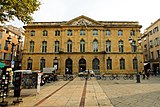Laurent Vallon
Laurent Vallon | |
|---|---|
| Born | 1652 |
| Died | 1724 |
| Nationality | French |
| Occupation | Architect |
| Children | Georges Vallon |
Laurent Vallon (1652-1724) was a French architect, mostly active in the Provence. Many of his buildings are now listed as monuments historiques.
Biography
[edit]Early life
[edit]Laurent Vallon was born in 1652. He received his training from Jacques and Jean Drusian.[1]
Career
[edit]He designed several Hôtel particuliers. In Aix-en-Provence, he was commissioned by Henri Reynaud d'Albertas (1674-1746) to design the Hôtel d'Albertas with Jean Lombard, which is listed as Monument historique.[2] It is located on the Place d'Albertas, which was designed by his son Georges and is also listed.[3] Together with Jean Daret and Jean Jaubert, he also designed the Hôtel d'Olivary located at 10 rue du Quatre-Septembre, also listed.[4] He also designed the facade of the Hôtel de Grimaldi-Régusse, a listed building located at 26, rue de l'Opéra.[5]
Additionally, he designed several Roman Catholic convents and a church. Together with Joseph Jaubert and Jean Vallon, he designed the Collège Mignet located on the rue Cardinale, then two Roman Catholic convents known as Couvent des Bénédictines (for the Order of Saint Benedict) and Couvent des Ursulines (for the Ursulines); it is listed.[6] On his own, he designed another convent, this time for the Jesuits, known as the Couvent des Jésuites located at 20 rue Lacépède, which is also listed.[7][8] Additionally, with Thomas Veyrier (1658-1736), he designed the Chapel of the Oblates located at 52-60 Cours Mirabeau, also listed.[9] Moreover, he designed the Église de la Madeleine in Aix, which was built from 1691 to 1703.[10][11][12] He also designed the Église Saint-Jean-Baptiste du Faubourg, located at 36 cours Sextius in Aix, built from 1697 to 1702, and listed since 1983.[13][14]
With his son, he designed the Halle aux grains, another listed building since 1983, which was built from 1717 to 1759 and now houses a post office and a library.[15]
In Marignane, together with Jean Daret, he designed the Château des Covet, which now serves as the townhall, also listed.[16]
Personal life
[edit]He had a son, Georges Vallon (1688-1767), who was also a renowned architect. He died in 1724.
Gallery
[edit]-
Hôtel d'Albertas (designed with Jean Lombard) in Aix-en-Provence
-
Hôtel d'Olivary (designed with Jean Daret and Jean Jaubert) in Aix-en-Provence
-
Hôtel de Grimaldi-Régusse in Aix-en-Provence, whose facade he designed
-
Collège Mignet, formerly the Couvent des Bénédictines and the Couvent des Ursulines, (designed with Joseph Jaubert and Jean Vallon) in Aix-en-Provence
-
Couvent des Jésuites in Aix-en-Provence
-
Facade of the Chapel of the Oblates in Aix-en-Provence
-
Église de la Madeleine (facade by Henri Révoil) in Aix-en-Provence
-
Église Saint-Jean-Baptiste du Faubourg in Aix-en-Provence
-
Halle aux grains (designed with his son) in Aix-en-Provence
References
[edit]- ^ Inès Castaldo, Le Quartier Mazarin. Habiter noblement à Aix-en-Provence. XVIIe ‑ XVIIIe siècles, colloque « Le Temps de l'Histoire », Aix-en-Provence: Publications de l'Université de Provence, 2011, p. 193
- ^ Base Mérimée: Hôtel d'Albertas, Ministère français de la Culture. (in French)
- ^ Base Mérimée: Immeubles formant la place d'Albertas, Ministère français de la Culture. (in French)
- ^ Base Mérimée: Hôtel d'Olivary dit aussi hôtel Paradis ou hôtel de Silvacane ou Revest-de-Montvert ou Pignet-Guelton, Ministère français de la Culture. (in French)
- ^ Culture 13: Hôtel de Grimaldi-Régusse Archived 2013-12-18 at the Wayback Machine
- ^ Base Mérimée: Couvent des Bénédictines et couvent des Ursulines (anciens), actuellement collège Mignet, Ministère français de la Culture. (in French)
- ^ Base Mérimée: Couvent des Jésuites (ancien), Ministère français de la Culture. (in French)
- ^ Jean-Jacques Gloton, Bibliothèque des écoles francaises d'Athènes et de Rome, E. de Boccard, 1979, Volume 237, Issue 2, p. 336 [1]
- ^ Base Mérimée: Ancien couvent des Carmélites, actuel couvent des Oblats, Ministère français de la Culture. (in French)
- ^ Base Mérimée: Eglise de la Madeleine, ou ancienne église des Prêcheurs, Ministère français de la Culture. (in French)
- ^ Liliane Counord, Jean-Paul Labourdette, Gérard Bernar, Dominique Auzias, Provence, Le Petit Futé, 2010, p. 166 [2]
- ^ Dominique Auzias, Jean-Paul Labourdette, Provence, Le Petit Futé, 2013, p. 172 [3]
- ^ Aix-en-Provence Tourism: Église Saint-Jean-Baptiste du Faubourg
- ^ Culture 13
- ^ Albert Aynaud, Aix-en-Provence, ses fontaines et leurs secrets, 10, bd Roi-René, 1969, p. 77 [4]
- ^ Base Mérimée: Ancien château des Covet de Marignane, actuel hôtel de ville, Ministère français de la Culture. (in French)









